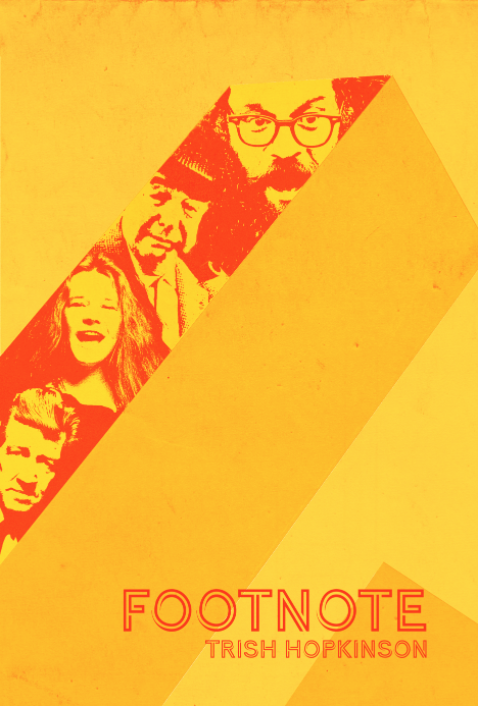ISSN: 1941-4137
POETRY THAT ENACTS THE ARTISTIC AND CREATIVE PURITY OF GLASS
POETRY THAT ENACTS THE ARTISTIC AND CREATIVE PURITY OF GLASS

Lucas Bailor is from Moreno Valley, California. His work has recently appeared or is forthcoming in Thin Air Magazine, Angel City Review, DUM DUM Zine, and SHARKPACK Poetry Review. He occasionally tweets: @lucasbailor.
April 24, 2018
Edited by Stephanie Kaylor
Edited by Stephanie Kaylor
Review of Footnote by Trish Hopkinson
 Footnote
by Trish Hopkinson
Lithic Press, 2017
I’ve been thinking a lot about the importance of audience in poetry lately. As perhaps the most intimate genre of writing, poetry is often an invitation to readers to step into a different world, an experience not their own. To echo Paul Celan, they are like a handshake: two peers coming together in an embrace of the hands as if to say, “Look at the differences of our palm lines. Here’s what mine mean to me.” But, of course, all of our handshakes look different. Some are a secret, complicated mix of gestures that one has to watch over and over to understand. Others are just a hand put out, waiting for another. The space I’ve been interested in exploring lately is that of the poet offering the secret, complicated mix. However, I haven’t been interested in the audience’s mimicry of my movements. Instead, I wonder how their own secret, complicated mixture of interpretation could perhaps complicate my own interaction with my poem, in order to create some kind of third entity. With all of these thoughts having been on my mind over the last year or two, I wandered into Trish Hopkinson’s chapbook, Footnote (Lithic Press, 2017), with a very particular set of eyes.
Footnote is a collection of response poems, with each poem having a footnote specifying who / what the poem is written for, after, or simply referencing. This creates a feeling somewhat like that secret, complicated mix mentioned above, except here Hopkinson is guiding the reader, stating the moves of the handshake as she makes them. In an interview with The Literary Librarian — and in the subtitle for her own website — Hopkinson calls herself a “selfish poet,” mentioning, “I write for me, the rest is just a bonus.” This sentiment plays out in Footnote through its very nature of being made up of response poems, simply due to response poems relying on the poet’s personal interpretation of a given piece or person rather than a more general, universally accepted interpretation.
The collection’s first poem, “A Way In” — for Amiri Baraka — begins, “As involved and still / as looking inward.” There are plenty moments throughout that provide this sort of meta commentary on the text, and beginning with these lines makes it easy to see this statement referring to poetry in general, but works perhaps even more effectively in relation to response poetry. For any doubters of response poetry, Hopkinson’s thesis seems to be that it is just “As involved and still.” Establishing the throughline in a collection of response poetry might even require more involvement than otherwise required, as the reader then has to consider how these responses work in conjunction with each other. The answer, really, is quite simple: they work because they matter to Hopkinson.
This is where I begin to understand Hopkinson’s self-identification as a “selfish poet.” A response poem requires the writer to take a new sort of ownership over the initial writer’s work and relies on the writer’s own interpretations which may be entirely secret to the writer and unknown to the audience. The best example of this is Hopkinson’s pairing of Nick Cave and the Bad Seeds with Rainer Maria Rilke in “From Her to Eternity,” and reminds me of when I once made a cut-up poem of lyrics from Bon Iver and the poetry of Paul Celan. These combinations are, perhaps, entirely unique to the writer and require the reader to experience this connection they had maybe never considered before. And this, of course, is what we often look for in poetry and writing in general: those conceptions of the world we have yet to know or understand.
There are also times in Footnote where Hopkinson decides to use “after” instead of “for,” which occasionally means a poem that follows along in the style of the original. This is seen most presently in “Waiting Around,” after Pablo Neruda’s “Walking Around.” Hopkinson follows the skeletal frame of Neruda’s original, beginning, “It so happens, I am tired of being a woman.” The poem progresses with ruminations on being a mother, a wife, a poet, and much more, but most notably opts for examining the banal:
That’s why the year-end gapes with pointed teeth,
growls at my crow’s feet, and gravels into my throat.
It claws its way through the edges of an age
I never planned to reach
and diffuses my life into dullness—
workout rooms and nail salons,
bleach-white sheets on clotheslines,
and treacherous photographs of younger me
at barbecues and birthday parties.
By reflecting both on aging and the banal in a simultaneously light-hearted and contemplative manner, Hopkinson offers something new to our understanding of either walking or waiting around, which is often the goal of a response poem.
There are a few moments in the collection where I wonder if I would have appreciated the chance to read the poems without the footnotes and thus to discover the influence through a close reading. The poem, “Pearl at the Studio Mic,” has one of my favorite moments in the collection:
She hurls raucous
and rough like swallowing
grind, like wood hell against grit,
against hurts and fret.
Her rumblings burst out.
Her spit stings my metal.
Her eyes and skin wad and jam.
She’s rocking, cradling my coolness
in her hot, wet hands.
Being told from the outset that the poem is for Janis Joplin, I perhaps go in with my own conception of Janis Joplin and allow the poem to affirm that for me, as opposed to the potential of going in without knowing who it is referring to and then getting to discover it on my own. Or in “Whimper” — presented with the footnote, “after Allen Ginsberg’s ‘Howl’” — the reader is potentially bringing their own conception before, rather than after, reading Hopkinson’s response. This poem contains one of the best punches in the collection, and also the shortest: “I whimper.” But how might I respond to that if I had to figure out it was a response after “Howl” rather than being told? This is, of course, one of the questions of response poetry in general, the question of how much credit to give and when to give it.
At the end of “A Way In,” Hopkinson writes, “Awakened. Convoluted / & looking inward. I evaporate”. Instead of looking towards the negative connotation of “convoluted,” I like reading this in terms of it representing something being twisted or coiled. Throughout Footnote, Hopkinson twists her inspirations, her favorites, and her knowledge into an intensely personal conception of the response poem. “Our smallness is truth,” she writes in “Whimper.” And perhaps our own conceptions we instill in what we read and know is just one representation of that smallness, of that truth.
Visit Trish Hopkinson's Website
Visit Lithic Press' Website
Footnote
by Trish Hopkinson
Lithic Press, 2017
I’ve been thinking a lot about the importance of audience in poetry lately. As perhaps the most intimate genre of writing, poetry is often an invitation to readers to step into a different world, an experience not their own. To echo Paul Celan, they are like a handshake: two peers coming together in an embrace of the hands as if to say, “Look at the differences of our palm lines. Here’s what mine mean to me.” But, of course, all of our handshakes look different. Some are a secret, complicated mix of gestures that one has to watch over and over to understand. Others are just a hand put out, waiting for another. The space I’ve been interested in exploring lately is that of the poet offering the secret, complicated mix. However, I haven’t been interested in the audience’s mimicry of my movements. Instead, I wonder how their own secret, complicated mixture of interpretation could perhaps complicate my own interaction with my poem, in order to create some kind of third entity. With all of these thoughts having been on my mind over the last year or two, I wandered into Trish Hopkinson’s chapbook, Footnote (Lithic Press, 2017), with a very particular set of eyes.
Footnote is a collection of response poems, with each poem having a footnote specifying who / what the poem is written for, after, or simply referencing. This creates a feeling somewhat like that secret, complicated mix mentioned above, except here Hopkinson is guiding the reader, stating the moves of the handshake as she makes them. In an interview with The Literary Librarian — and in the subtitle for her own website — Hopkinson calls herself a “selfish poet,” mentioning, “I write for me, the rest is just a bonus.” This sentiment plays out in Footnote through its very nature of being made up of response poems, simply due to response poems relying on the poet’s personal interpretation of a given piece or person rather than a more general, universally accepted interpretation.
The collection’s first poem, “A Way In” — for Amiri Baraka — begins, “As involved and still / as looking inward.” There are plenty moments throughout that provide this sort of meta commentary on the text, and beginning with these lines makes it easy to see this statement referring to poetry in general, but works perhaps even more effectively in relation to response poetry. For any doubters of response poetry, Hopkinson’s thesis seems to be that it is just “As involved and still.” Establishing the throughline in a collection of response poetry might even require more involvement than otherwise required, as the reader then has to consider how these responses work in conjunction with each other. The answer, really, is quite simple: they work because they matter to Hopkinson.
This is where I begin to understand Hopkinson’s self-identification as a “selfish poet.” A response poem requires the writer to take a new sort of ownership over the initial writer’s work and relies on the writer’s own interpretations which may be entirely secret to the writer and unknown to the audience. The best example of this is Hopkinson’s pairing of Nick Cave and the Bad Seeds with Rainer Maria Rilke in “From Her to Eternity,” and reminds me of when I once made a cut-up poem of lyrics from Bon Iver and the poetry of Paul Celan. These combinations are, perhaps, entirely unique to the writer and require the reader to experience this connection they had maybe never considered before. And this, of course, is what we often look for in poetry and writing in general: those conceptions of the world we have yet to know or understand.
There are also times in Footnote where Hopkinson decides to use “after” instead of “for,” which occasionally means a poem that follows along in the style of the original. This is seen most presently in “Waiting Around,” after Pablo Neruda’s “Walking Around.” Hopkinson follows the skeletal frame of Neruda’s original, beginning, “It so happens, I am tired of being a woman.” The poem progresses with ruminations on being a mother, a wife, a poet, and much more, but most notably opts for examining the banal:
That’s why the year-end gapes with pointed teeth,
growls at my crow’s feet, and gravels into my throat.
It claws its way through the edges of an age
I never planned to reach
and diffuses my life into dullness—
workout rooms and nail salons,
bleach-white sheets on clotheslines,
and treacherous photographs of younger me
at barbecues and birthday parties.
By reflecting both on aging and the banal in a simultaneously light-hearted and contemplative manner, Hopkinson offers something new to our understanding of either walking or waiting around, which is often the goal of a response poem.
There are a few moments in the collection where I wonder if I would have appreciated the chance to read the poems without the footnotes and thus to discover the influence through a close reading. The poem, “Pearl at the Studio Mic,” has one of my favorite moments in the collection:
She hurls raucous
and rough like swallowing
grind, like wood hell against grit,
against hurts and fret.
Her rumblings burst out.
Her spit stings my metal.
Her eyes and skin wad and jam.
She’s rocking, cradling my coolness
in her hot, wet hands.
Being told from the outset that the poem is for Janis Joplin, I perhaps go in with my own conception of Janis Joplin and allow the poem to affirm that for me, as opposed to the potential of going in without knowing who it is referring to and then getting to discover it on my own. Or in “Whimper” — presented with the footnote, “after Allen Ginsberg’s ‘Howl’” — the reader is potentially bringing their own conception before, rather than after, reading Hopkinson’s response. This poem contains one of the best punches in the collection, and also the shortest: “I whimper.” But how might I respond to that if I had to figure out it was a response after “Howl” rather than being told? This is, of course, one of the questions of response poetry in general, the question of how much credit to give and when to give it.
At the end of “A Way In,” Hopkinson writes, “Awakened. Convoluted / & looking inward. I evaporate”. Instead of looking towards the negative connotation of “convoluted,” I like reading this in terms of it representing something being twisted or coiled. Throughout Footnote, Hopkinson twists her inspirations, her favorites, and her knowledge into an intensely personal conception of the response poem. “Our smallness is truth,” she writes in “Whimper.” And perhaps our own conceptions we instill in what we read and know is just one representation of that smallness, of that truth.
Visit Trish Hopkinson's Website
Visit Lithic Press' Website
Glass: A Journal of Poetry is published monthly by Glass Poetry Press.
All contents © the author.
All contents © the author.





